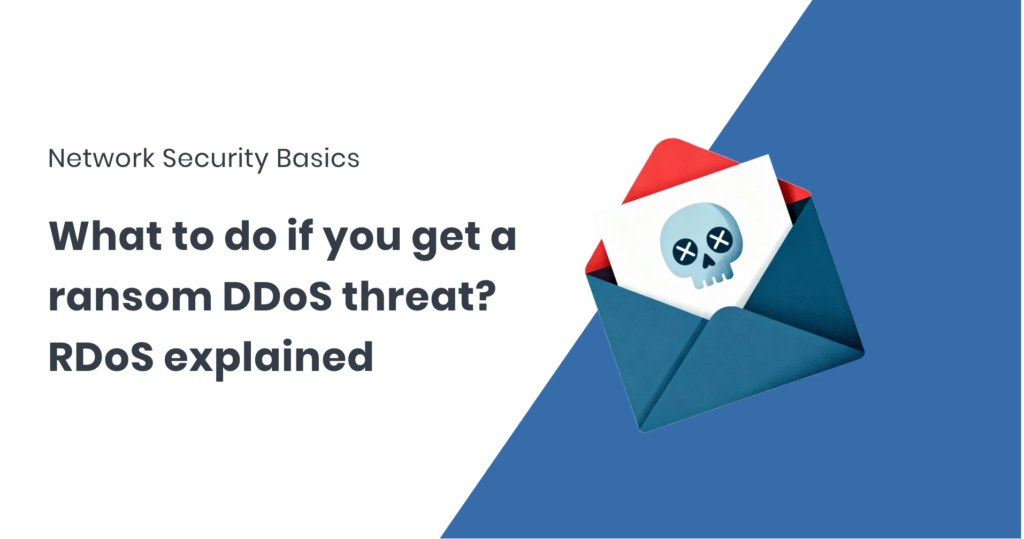Every now and then, a network operator’s inbox lights up with a DDoS ransom note — bold claims, big threats, and a bitcoin address waiting for payment. We’ve seen plenty of them ourselves. Some come from actors with real bandwidth behind them; others are clearly written by people who just discovered a booter service. A few are serious, many are ludicrous, and all share the same goal: to scare you into reacting. In this article, we’ll unpack what these ransom DDoS threats are about, why they happen, and what you should actually do when one lands in your inbox.
Understanding Ransom DDoS
Ransom Distributed Denial-of-Service (RDDoS) — also known as RDoS — is a form of cyber-extortion in which attackers threaten to overwhelm an organisation’s online infrastructure with massive traffic floods unless a ransom is paid. Unlike ransomware, there is no data theft or encryption; the damage comes from disruption. Attackers rely on fear of downtime, financial loss, and reputational harm to coerce victims into compliance.
These campaigns often begin with a short, menacing email sent to public addresses such as noc@ or abuse@, claiming that a powerful attack will begin within hours unless a payment is made in cryptocurrency. Some actors run small “demo” floods to appear credible, while others never send a single packet. The goal is to create urgency and panic — not necessarily to deliver a technically complex attack.
A Short History of RDDoS
The concept of pairing denial-of-service with extortion has existed for over a decade. Early organized campaigns surfaced in the mid-2010s, when groups realized that threatening disruption could be just as profitable as stealing data. Since then, RDDoS has matured alongside the broader DDoS ecosystem.
Modern attacks are powered by vast botnets composed of compromised IoT and cloud-based systems, capable of delivering multi-terabit floods. Yet many RDDoS campaigns never reach that stage. During global waves of extortion, thousands of ransom emails are sent to potential victims, but only a handful result in actual traffic. Even so, the psychological and operational stress of receiving such threats keeps the tactic effective.
How the Attackers Operate
Most RDDoS actors are not highly technical criminals. Many simply harvest contact information for suitable targets — often organizations with visible online services — and send out mass-produced ransom notes in bulk. When a recipient reacts, the attackers may rent capacity from booter or stresser services to launch a modest flood, buying a few minutes of noise to appear credible. These operators typically reside in regions where cybercrime enforcement is weak or nonexistent, allowing them to continue their campaigns with little risk of prosecution.
The more capable groups follow a predictable pattern: an initial ransom note, an optional proof-of-capability attack, and sometimes a brief escalation if ignored. The underlying traffic is conventional DDoS — UDP amplification through DNS or NTP, TCP SYN or ACK floods, or HTTP floods targeting application endpoints. What distinguishes RDDoS from generic denial-of-service is the extortion layer — a human message added to a mechanical attack.
From a defender’s standpoint, every ransom note should be logged, timestamped, and correlated with traffic monitoring. The real question is not whether to respond but how to confirm if any actual flood follows. In most cases, no attack materializes, and the threat disappears as quickly as it arrived.
Responding to a Ransom DDoS Threat
The correct response to a ransom DDoS threat is consistent and simple: never pay, never reply, and never engage with the criminals in any way. Paying offers no protection and signals weakness, inviting repeat attempts. There is no negotiation, no honor among extortionists, and no guarantee the attack will stop.
Instead, quietly prepare. Confirm that your monitoring systems are active, thresholds calibrated, and mitigation automation ready. If an attack follows, activate your filtering and traffic diversion mechanisms according to plan. Keep detailed logs of the ransom message and any related traffic patterns for internal review and, if necessary, later reporting to law enforcement.
If no traffic follows — as is often the case — there is no need for public escalation or panic. Treat it as background noise and an opportunity to validate your readiness. Only when real attack traffic appears should coordination with upstream providers or mitigation partners become necessary.
In a nutshell
Ransom DDoS thrives on fear and uncertainty. The attackers count on victims reacting emotionally, not operationally. The real defence is composure: understand the threat, monitor for activity, and maintain proven mitigation workflows. When your network and team are prepared, a ransom DDoS threat is just another event to record and move past — not a crisis to negotiate.
The goal is resilience. Build strong detection, responsive filtering, and clear incident procedures so that when the next ransom note arrives, you can log it, monitor for anomalies, and simply ignore it — not debate it.
About FastNetMon
FastNetMon is a leading solution for network security, offering advanced DDoS detection and mitigation. With real-time analytics and rapid response capabilities, FastNetMon helps organisations protect their infrastructure from evolving cyber threats.
For more information, visit fastnetmon.com.

